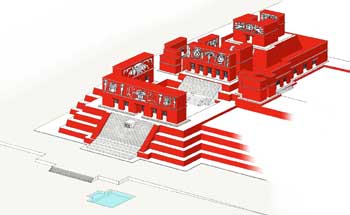
| FAMSI © 2008: Tomás Barrientos |
||
Hydraulic Systems in Central Cancuén: Ritual, Reservoir, and/or Drainage?
Research Year: 2005 Table of Contents
Abstract The Cancuén Archaeological Project’s 2005 field season included research of several hydraulic systems, thanks to funds provided by FAMSI. These features are important not just for the interpretation of water management at the site, but also to revise and criticize several theories and general models on this subject. Hydraulic systems in Cancuén consist of small-scale canals and water reservoirs, which had different functions, such as supplying water for domestic use, the drainage of plazas, and performing ritual activities. Among these features stands out the discovery of a pool located at the Royal Palace’s main entrance which has unique characteristics for the whole Maya area. Its function was linked with ritual, political, and diplomatic activities, which could have been performed in the palace. Excavation of the royal pool also included an important discovery, consisting in the skeletal remains of over 30 people, as well as a great amount of flint points and personal ornaments of shell and green stone. Archaeological analysis of these artifacts and of the deposit’s context, as well as the assistance provided by forensic analysis, indicate that this was a massacre that took place at the end of Cancuen’s occupation, probably the violent murder of the royal family. The data gathered in Cancuén during the 2005 season show that the use and meaning given to water among the Prehispanic Maya were varied, therefore they must be interpreted according to the conditions pertaining to each settlement. We have to take into account the scale of hydraulic features, their context within the site and their possible function according to water availability for the inhabitants. La Temporada de Campo 2005 del Proyecto Arqueológico Cancuén incluyó investigaciones de varios sistemas hidráulicos, gracias a los fondos proporcionados por FAMSI. Estos son rasgos importantes para la interpretación no solo del manejo de agua en el sitio, sino también para revisar y criticar algunas teorías y modelos generales sobre este tema. Los sistemas hidráulicos en Cancuén consisten de canales y reservas de agua de escala pequeña, los cuales tuvieron distintas funciones, que incluyen abastecimiento para uso doméstico, drenaje de plazas y uso para actividades rituales. Dentro de estos rasgos destaca el descubrimiento de una piscina ubicada en la entrada principal del Palacio Real, la cual tiene características que son únicas para toda el Área Maya. Su función esta relacionada con las actividades rituales, políticas y diplomáticas que se pudieron llevar a cabo en el Palacio. La excavación de la Piscina Real también incluyó un importante descubrimiento, consistente en los restos óseos de más de 30 individuos, así como una gran cantidad de puntas de pedernal y ornamentos personales de concha y piedra verde. El análisis arqueológico de los artefactos y contexto de este depósito, así como la ayuda de análisis forenses, indican que se trata de una masacre ocurrida durante el final de Cancuén, posiblemente el asesinato violento de la familia real. Los datos recabados en Cancuén durante la temporada 2005 demuestran que el uso y significado del agua por parte de los mayas prehispánicos fue variado, y por lo tanto se debe interpretar de acuerdo a las condiciones propias de cada asentamiento. Se debe tomar en cuenta la escala de los rasgos hidráulicos, su contexto dentro del sitio y su posible función de acuerdo a la disponibilidad de agua por parte de los habitantes. For those with a fast connection, download the complete PDF file: Hydraulic Systems in Central Cancuén: Ritual, Reservoir, and/or Drainage? (9.06 MB) For those with slower connections download the PDF file in sections:
Part I (6.32 MB) The PDF files require Adobe Acrobat Reader.
Submitted 07/18/2006 by: |
||
|
Text links to all pages at this site are available at the FAMSI INDEX |
||

